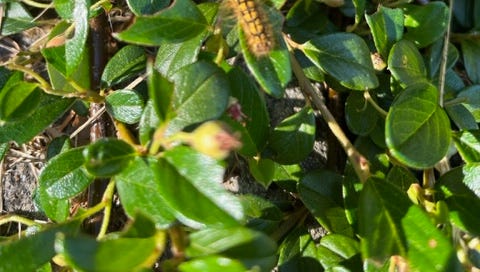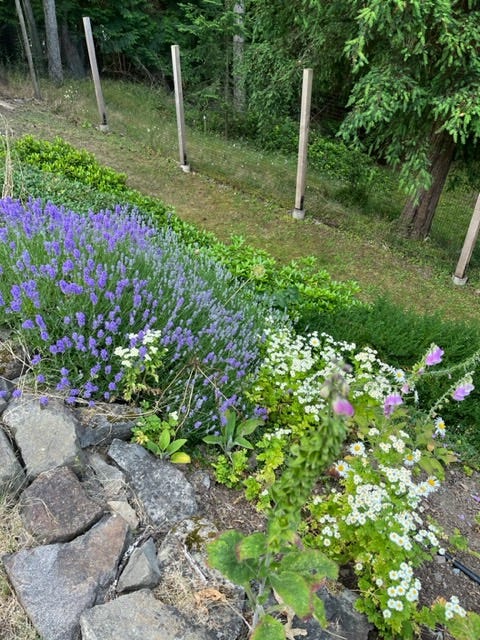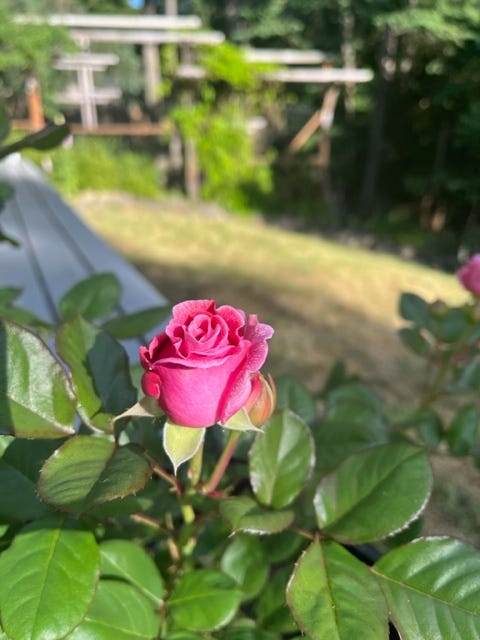When my Buddhist friend Kate plucks tent caterpillars from her orchard, she says sweetly, “May you be reborn into a better life,” and drops them into a bag she’ll put in the garbage.
When I pick tent caterpillars, wincing at the feel of all those grippy little feet that want to clutch on to my fingers, I say, “There, plant, doesn’t that feel better?” And my viburnums and cotoneasters say, Yes, actually, much improved. I swear I can feel the plants’ thankfulness fizzing up like spray from a waterfall. It helps me get on with a task I find truly disgusting. Gradually my yogurt container, half-filled with water and a squirt of dish soap, gets thick with caterpillars. Eventually I’ll add them to the compost pile
Google claims many bird species chow down on the Eastern tent caterpillar. However, we don’t have most of those birds in BC. Robins are supposed to eat them, but despite a large population of robins in my yard, I’ve never seen a robin go after a tent caterpillar. Thinking I must be out of date, I asked Andy, my naturalist friend, “What birds eat Western tent caterpillars?”
“Our Pender Island birds won’t touch them,” she said. “That’s why they’re such a problem here. It’s the same in northern Alberta, as well. We were up there with the kids one time for a music fest and the ground was seething with them. You couldn’t walk outside without squishing hundreds of caterpillars underfoot. The kids didn’t even want to go out.”
Our island’s had a bad infestation this year. Now, I know tent caterpillars are a native species. But I’m finding my horror at these writhing infestations dies hard. When I discovered caterpillars crawling on some of my valued bushes and groundcovers, it didn’t take long for me to move into protective plant-momma-mode. On a warm day, the caterpillars can hump around at high speed. They’re orange-furred and as long as a baby finger.
For whatever reason, my garden has been spared the hundreds of nests that some parts of the island are dealing with, and, supposedly, the season for caterpillars is winding down. I tell myself that I don’t have to get every caterpillar, just some. Consistency is key. I pick infested areas in my yard around five times a day. Great for balance, if you have one foot on a rock wall and are trying not to fall over a ten-foot cliff.
Here’s a bit of horror-trivia: the main predator of tent caterpillars is a parasitoid fly which lays eggs on their heads. When the eggs hatch, they eat the caterpillar alive. Most of the caterpillars I see have a white mark on their foreheads. Those are the eggs.
“May you be reborn into a better life,” Kate says to the caterpillars as she protects her orchard.
In my garden, I side with rooted life. In straggles of early summer sun with pink foxgloves and pops of white feverfew in bloom, I hold to the sweetness of that cherishing between person and plant. And if I want to imagine that the cotoneasters and viburnums beam back appreciation for being freed from the itch and ache of biting mouthparts, that’s my story and I’m sticking to it.
I’m a bad Buddhist. I deposit a caterpillar into my container of water, say, “You’re getting off light, bud. I’m saving you from a terrible fate.”
Before the caterpillars found my potted rose.
I owe you guys a book draw and recent news. Next time! Besides picking caterpillars, I’ve been grappling with health issues that have me thinking about the Norse concept of wyrd, or fate, which is, “Meet your wyrd with dignity.”








I had a friend Mikey, who showed me how wyrd works in real life. Take Care and continue to share ✌🏻
The struggle is real. I am a bad person who hates to kill things. I am now onto mice. I also use a coffee pod machine. That might be worse.